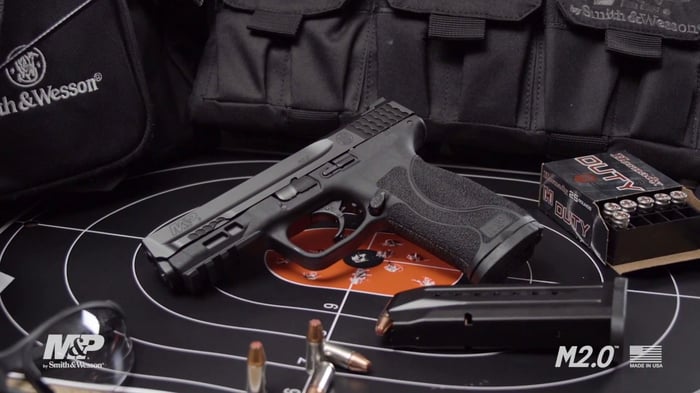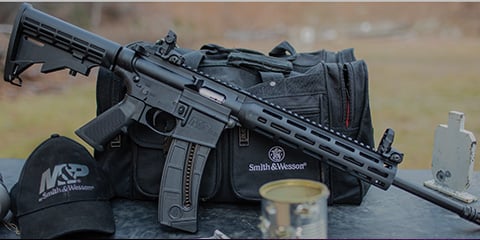It's not surprising the owner of the Smith & Wesson brand makes most of its money from guns, but a closer look at American Outdoor Brands' (SWBI -1.02%) operations reveals it's a lot more nuanced than just that broad category.
So, let's dive in more deeply and see just where the gunslinger really shoots out the lights to generate sales and profits.

Smith & Wesson M&P 2.0. Image source: Smith & Wesson.
A history of firsts
With a company pedigree that extends back to the 1850s, Smith & Wesson has made significant contributions to the firearms industry, and its handguns are world-famous. From the Smith & Wesson Model 1, the first revolver to use self-contained cartridge ammunition, through the development in 1935 of the first Magnum revolver, the .357 Magnum, the revolver has been closely associated with the gunsmith. The .44 Magnum popularized by Clint Eastwood in the Dirty Harry movies would come out 20 years later and is arguably Smith & Wesson's most famous handgun ever produced.
Yet today, semi-automatic pistols are the more popular handgun on the market. According to the most current data available from the Bureau of Alcohol, Tobacco, Firearms & Explosives, there were more than 3.5 million semi-autos manufactured in 2015 compared to just 885,000 revolvers. Although the number of "wheelguns" is down from the peak of 4.4 million in 2013, and revolvers are up from 725,000 that year and have actually been fairly steadily climbing in number for years, there are still four times as many pistols made as revolvers.
That divergence largely holds true for American Outdoor Brands as well, which produced almost 990,000 semi-autos in 2015 compared to 274,000 revolvers. Similarly, industry peer Sturm, Ruger (RGR -0.41%), the country's largest gunmaker, manufactured almost 750,000 pistols and 256,000 revolvers.
The people's choice
American Outdoor doesn't break down the number of types of handguns it makes in its quarterly filings with the SEC, but instead it reports aggregate numbers of shipments and revenues generated. Over the first nine months of its current fiscal year, the gunsmith generated nearly $417 million from the sale of handguns, or 62% of its total net sales. It shipped 1.36 million handguns, or 81% of the total. It's safe to say it is the sale of semi-auto pistols that is producing the lion's share of American Outdoor's revenue.

Data source: American Outdoor Brands SEC filings. Chart by author.
For a long time now, concern for personal safety has been what's driving firearms sales, and the concealed carry market has been the primary force in handgun design. Compact, powerful, and lethal, concealed carry weapons have been the firearm of choice for millions of people purchasing a gun, and Smith & Wesson found success with its M&P Shield model, which was first produced in 2012 and quickly sold one million units. It has since introduced a .45 caliber version with even more stopping power.
While rifles are not about to overtake the production of handguns, it is notable that American Outdoor has increasingly been producing more long guns, and it shipped 64% more rifles over the first three quarters of the fiscal year than it did in the prior year, while only shipping 25% more handguns.
Long arm of the market
During the gunslinger's fiscal third-quarter earnings conference call with analysts, CEO James Debny noted that the weakness in the firearms market that followed the November election was primarily all in the handgun market. He noted that FBI gun buyer background checks through NICS declined 19% for handgun purchasers, but that number was down just 2% for those wanting to buy a long gun. Because American Outdoor is primarily a handgun manufacturer, that weighed on its quarterly results and led to it reducing its guidance for the year.

Image source: Smith & Wesson.
While the cliff might not have been as steep as originally feared, with NICS checks beginning to climb once more, it may still point to further weakness for the gunmaker than others might experience. Sturm, Ruger, for example, while obviously producing a large number of handguns, was able to surpass Smith & Wesson as the biggest gunmaker because it manufactured three times as many rifles as its rival did.
American Outdoor Brands is in no danger of going out of business, and its operations remain solid, but when it comes to where it makes its money, the Smith & Wesson brand of handgun is where it's at -- and even then, it is in semi-automatic pistols.





